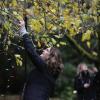May 20, 2008 - 2:36am
As Malaspina University-College transitions to Vancouver Island University, environmental concerns and sustainability are major priorities in all project planning.
Malaspina has been working on green initiatives for years, in an effort to increase energy efficiency and reduce its carbon footprint (the direct effect on the environment of carbon dioxide emissions).
“In the 1990s, we did an energy conservation review,” said Ric Kelm, Malaspina’s Director, Facilities Services and Campus Development. “That included a review of our electrical, heating, ventilating and air systems, as well as other energy conservation projects.”
As a result of that review, every new building built at Malaspina since 2000 is energy efficient. Malaspina went to the next level of energy efficiency in 2006 with its Faculty of Management building, which was built to be a Leader in Environmental and Energy Design (LEED) building with low energy lighting, motion sensor lighting, an energy efficient HVAC system, waterless urinals and high efficiency boilers. During the construction of the building, 75 percent of the construction waste was recycled or salvaged and diverted from the Nanaimo landfill.
“It is our goal to construct facilities that minimize the environmental footprint,” said Kelm. “It’s Malaspina’s way of showing leadership and setting an example in the region we serve. In this day and age, anything you can do to protect the environment during the design/construction and operational phase of a building makes good business sense. It’s good for employees and students.”
In 2000, Malaspina implemented a system of paid parking, which was created to reduce the number of single occupant vehicles coming to campus. Money collected from parking is used to fund environmental initiatives, including bike lockers, showers and other facilities designed to encourage alternate methods of transportation. Malaspina has also implemented the Propass, a permanent bus pass employees can acquire from the Regional District of Nanaimo through payroll deductions. Food waste from the cafeteria is also being composted to help reduce waste on campus.
Malaspina’s Campus Sustainability Committee is hard at work planning and implementing green initiatives and overseeing investments of parking fees in sustainability projects. Their focus includes waste reduction, energy efficiency and reducing greenhouse gas emissions.
“Malaspina recognizes the importance of making a contribution to the fight against global climate change and the need to become a more sustainable organization, for our campus and our environment,” said Steven Beasley, Chair of Malaspina’s Campus Sustainability Committee and Executive Director of the Student’s Union.
“Currently, the biggest sustainability initiative at Malaspina is the Campus Master Plan,” said Beasley. “A huge part of it will include sustainability planning. Our committee will be working to take suggestions from the master plan process, move them forward and implement them. That plan will be our road map for sustainability.”
The Malaspina Campus Master Plan will set out strategic and organized plans for campus development, practices and operations. Sustainability is a major priority in that process. As Malaspina transitions to university status, Beasley says sustainability will continue to be a priority, not just for the sake of the campus, but for the continued betterment of the community.
“It’s not just about making Malaspina greener,” said Beasley. “Sustainability considers social, environmental and economic factors in determining the kind of institution and community we want to create for future generations. We want our students, faculty and staff to embrace an environmental consciousness and consider sustainability, not just while they are at Malaspina, but in their everyday lives. Our goal is to promote awareness, dialogue and action so that people within our communities, both on and off campus, can help correct the damage we have done to our environment.”
Malaspina’s commitment to environmental action goes beyond operational and facility issues to include academic work and curricular expansions. September 2008 will see the creation of a new Green Building and Renewable Energy Technician program. This two-year diploma program teaches students about energy efficiency and renewable energy applications in buildings. The new Green Building program is part of an ongoing effort to incorporate environmental issues into the curriculum.
While Malaspina has implemented many initiatives in the last few years to reduce its carbon footprint, Kelm and Beasley say they are still looking ahead and finding ways to make the campus increasingly sustainable.
“Although it’s a challenge, it’s exciting to be a part of the implementation of these environmental and sustainable practices,” said Kelm.
Tags: In the Community






